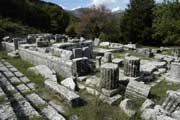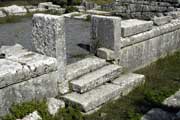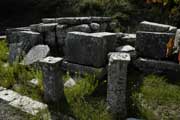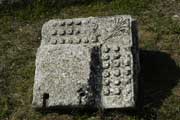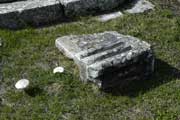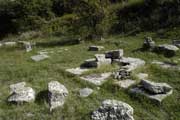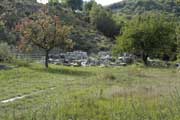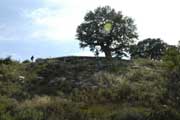.
Periphery:Peloponnese
Prefecture : Arcadia

Coordinates 37°23′ N 22°1′ E
Periphery Megalopolis
Population 0
Elevation 568 m
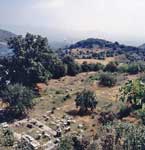
Lycosura (Greek, Ancient: Λυκόσουρα, Λυκόσουρα, Modern: Palaeokastro or Siderokastro) was a city of Arcadia reputed to be the most ancient city in Greece and, indeed, the world. Its current significance is chiefly associated with the sanctuary of the goddess Despoina, which contained a colossal sculptural group perhaps made by Damophon of Messene; this group is comprised of acrolithic statues of Despoina and Demeter seated on a throne, with statues of Artemis and the Titan gus standing on either side of them. The dates of both the temple and the sculptural group have occasioned some dispute. Remains of a stoa, altars and other structures have also been found. The Sanctuary of Despoina at Lycosoura is located at 37° 23' 22.54" N, 22° 1' 51.67" E, 9 km WSW of Megalopolis, 6.9 km SSE of Mt. Lycaion, and 160 km SW of Athens. There is a small museum at the archaeological site housing small finds as well as part of the cult group, while the remains of the cult statues of Despoina and Demeter are displayed at the National Archaeological Museum of Athens.
Mythology and History
--------------------------------------------------------------------------------
The chthonic goddess worshiped by the Arcadians under the title Despoina (Δέσποινα: the Mistress), later conflated with Kore, was originally considered to be the daughter of Poseidon Hippios and Demeter, rather than of Zeus and Demeter as was Kore.[1] Her real name could not be revealed to anyone except those initiated to her mysteries at Lycosura; this name is consequently unknown.
In the 2nd century AD, the Greek periegetic writer Pausanias, relying on personal observations, available texts, and consultation with local persons, wrote the only extant account of the city and its sanctuary. He relates that Lycosura was founded by Lycaon the son of Pelasgus [2] and that it was the oldest city in the world.[3] He notes that Cleitor the grandson of Arcas (whence the toponym Arcadia) dwelled in Lycosura.[4]
In 368/7 .BC, when many cities in the region were unified into the city of Megalopolis through persuasion or force, the citizens of Lycosura, Trapezus, Lycaea, and Tricoloni refused to relocate.[5] The citizens of Trapezus were massacred or driven into exile by the Arcadians, but the citizens of Lycosura were spared due to reverence for the Sanctuary of Despoina, where they had sought asylum.[6] Many of the cities of the region were thus abandoned in favor of Megalopolis and their sanctuaries fell out of use.[7] Pausanias states that the Sanctuary of Despoina was 40 stades (7.4 km) from Megalopolis, which exercised political control over the sanctuary.[8] In the 2nd century AD a statue of the emperor Hadrian was dedicated in the temple. Coins from Megalopolis of the Severan period in the early 3rd century AD appear to depict the cult statue group. [7] Despite its significance to the Arcadians and occasional notice from the wider Mediterranean world, the cult of Despoina appears to have remained tied to this one sanctuary at Lycosura.[9]
Archaeology
Overview of the Site
The site of Lycosura occupies a hill of 632 m in the wooded, mountainous region South of the river Plataniston. The Sanctuary of Despoina is sited in a declivity on the North-Eastern face of the hill occupied by the city. The temple and considerable remains of the cult statuary group were discovered in 1889 AD by the Greek Archaeological Society, well before the advent of stratographic excavation techniques. Dating of the finds and structures thus remains problematic, although later excavations and studies have attempted to clarify the situation. While the site of the city remains largely unexcavated, the Sanctuary of Despoina has been thoroughly uncovered and consists of a temple, a stoa, an area of theater-like seats, three altars, and an enigmatic structure conventionally called the Megaron. Pausanias also describes a temple of Artemis Hegemone (Artemis the Leader) at the entrance to the sanctuary on its eastern side; [10] this structure and a number of others mentioned by the author have not to date been identified archaeologically. Traces of the temenos wall (boundary of the sacred area) have been detected on the North and the East sides of the sanctuary; the southern and western limits of the sacred area are thus unknown.
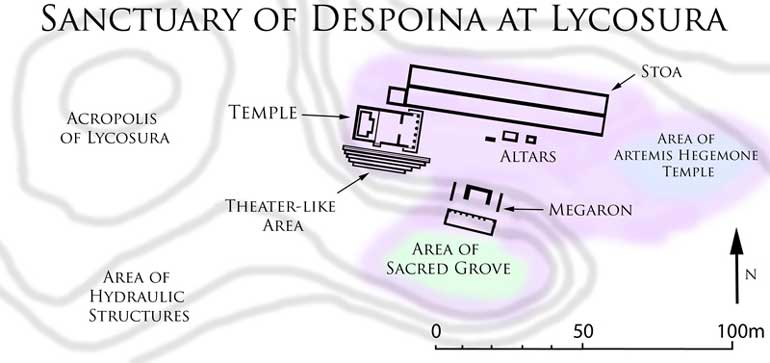
Area shaded purple approximates the sacred precinct. (Source)
Temple, Stoa, and Altars
The Temple of Despoina is prostyle-hexastyle in plan and in the Doric order - i.e. it had six Doric columns across the front façade only. In plan, the stylobate (platform) of the temple measures 11.15 by 21.35 m and is divided between a pronaos (front portico) and a cella.[9] The lower portion of the walls of the temple's cella are built of limestone, consisting of a course of orthostates capped by two string courses; the walls are then completed to the level of the roof in fired clay brick, which would then have been plastered. The six columns of the façade are in marble, as is the entablature. A curious feature of this temple is the doorway in the South wall facing the theater-like area. Although uncommon, side doorways are known from other temples in Arkadia: i.e. Athena Alea at Tegea, and Apollo Epikourios at Bassai. Rather than extending as steps along the four sides of the temple, the stepped crepidoma spans only the front of the temple and has returns on the sides as far as the antae. The architecture also deviates from the standard Doric schema in that its Doric frieze is 1.5x the height of the architrave. [11] At the rear of the cella is a massive, c. 1m high stone podium designed to hold the cult statuary group, in front of which is a mosaic decorating the floor. General consensus holds that the first construction of this temple dates to the 4th century .BC. There were several repairs in the Roman period.
To the South of the temple, inset into the slope of the hill, is a theater-like area comprised of ten rows of stone seats ranging from 21 to 29 m in length. These rows of seats are un-curved and parallel with the South wall of the temple.
To the NE of the temple, there was a Stoa also in the Doric order with a single story and an internal colonnade, measuring 14 by 64 m. Foundations for a room of uncertain function measuring 5.5 by 6 m are connected to the West end of the stoa. Pausanias reports that the stoa contained a panel painted with matters pertaining to the mysteries and four bas relief sculptures in white marble depicting: [12]
- (1) Zeus and the Fates
- (2) Hercules wrestling Apollo for the Delphic tripod
- (3) nymphs and pans
- (4) Polybios the historian with an inscription.
Similar use of a stoa to display artwork is know for the Stoa Poikile (Painted Stoa) of ancient Athens.
View of the Sanctuary of Despoina Looking WNW from the Area of the Megaron
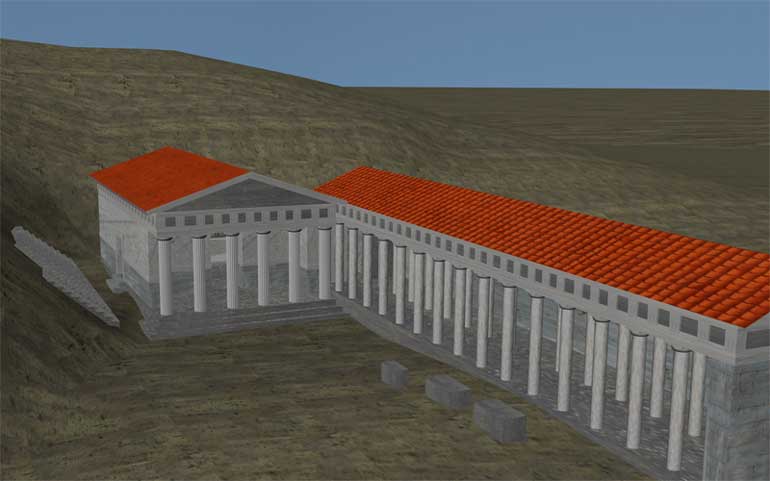
From L-R: theater-like area, temple of Despoina, stoa, altars. (Source)
Three small, stone altars were found in the area c. 15m to the East of the temple dedicated to Despoina, Demeter, and the Great Mother respectively.[13] Many votive gifts and offerings were found in the excavation of the sanctuary.
Megaron and Beyond
The structure termed the Megaron (Great Hall) after Pausanias is poorly preserved but secure in its essential plan, measuring 9.5m in width by 12m in depth. It the view of William Dinsmoor, this structure can be reconstructed as a monumental altar with stairways flanking both sides and having a small stoa at its top - comparable to the Great Altar of Zeus at Pergamon. Of great interest are the over one hundred and forty terra cotta figurines having the heads of sheep or cows that were found in the area of the Megaron.
The great majority of these are female and closely resemble the decorative figures carved into the veil of the colossal head of Despoina. [14] <br
Beyond the Megaron, Pausanias also notes the presence of a grove sacred to Despoina surrounded by stones with altars of Poseidon Hippios and other gods beyond that, with one altar stating that it is sacred to all the gods. From there it was possible to access a shrine of Pan via a flight of stairs.[15] Associated with this shrine were an altar of Ares, two statues of Aphrodite (one marble one wooden - a xoanon - and older), wooden images (xoana) of Apollo and Athena, and a sanctuary of Athena. These features have not been securely located.
Remains Outside the Sanctuary
Outside of the sanctuary and sixty meters SW of the temple, on the opposite side of the ridge running SE to NW up to the hill of the acropolis, a number of structures of Hellenistic and Roman date have been uncovered that may have hydraulic functions, perhaps a nymphaeum (fountain-house) and a complex of Roman thermae (baths).[9] Some remains of the city wall have also been traced.
Cult Sculptural Group
Although in many fragments and not completely preserved, the colossal cult group attributed to Damophon by Pausanias has been extensively studied and described. [7]

1734 : Head of Demeter. Lykosoura
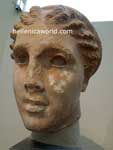
1735 : Head of Artemis . Lykosoura
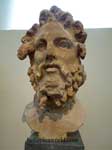
1736 : Head of Anytos.
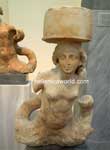
2171 : Tritoness. Lykosoura
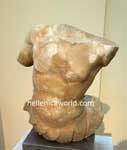
2172 : Tritoness. Lykosoura
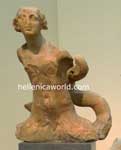
2174 : Tritoness. Lykosoura

2175 : Tritoness. Lykosoura
From L-R: Artemis, Demeter, Veil of Despoina, Anytus, Tritoness from the throne. (Source
The images of the goddesses themselves and the throne on which they sit, and the footstool under their feet are of one stone. ... The images are about the same size as that of the Mother among the Athenians. These are works of Damophon. Demeter bears a torch in her right hand, and she has placed her other hand on Despoina. On her knees, Despoina has a scepter and what is called the Cista (box), which is held in her right hand. On either side of the throne, Artemis stands beside Demeter clothed in the hide of a deer, and having a quiver on her shoulders, and one hand there is a torch and in the other two snakes. A dog lies beside Artemis, the sort that is appropriate for hunting. Beside the image of Despoina stands Anytus, portrayed as a representation of a man in armor. -Pausanias 8.37.3-5
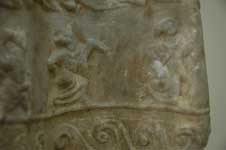
Detail of the veil of Despoina
Significance of the Site
In addition to the find of the Acrolithic statues commonly attributed to Damophon, this temple is important for the study of ancient Greek religious practice due to the unusual feature of its side doorway coupled with a theater-like area. Several authors have postulated that the side doorway and theater-like area were created to allow a ritual for the mystery cult of Despoina to take place, perhaps an epiphany of the goddess.
According to Pausanias, the Megaron (Μέγαρον) was the location for major sacrifices to Despoina by the Arcadians and the location where they enacted the mysteries of the goddess.[16] The mode of sacrifice at the Megaron was unusual in that it involved hacking a limb from the sacrificial animal rather than cutting its throat. The similarity of the figurines found in the vicinity of the Megaron and the dancing figures carved on the veil of Despoina may reveal something concerning the rituals of the cult. [14] The supposition that the site was a locus of cult activity from considerable antiquity is supported by the presence of multiple xoanon-type cult statues, by the unusual mode of sacrifice, and by the special veneration shown to the sanctuary by the Arcadians in 368/7 .BC as discussed above. Like Eleusis and Samothrace, Lycosura is an important site for the study of ancient mystery religions and religion more broadly, although it remained a regional rather than a panhellenic or pan-Mediterranean cult.
Pausanias relates that the sculptural group of Despoina et al. was created by the eminent Hellenistic artist Damophon of Messene. [17] While Damophon has been placed at dates varying from the 4th century .BC to the age of Hadrian in the 2nd century AD, it is now generally accepted that he was active in the 2nd century .BC. He also states that the statues of Despoina and Demeter were worked from a single piece of marble without any use of iron clamps or mortar. [18] As these statues are acrolithic in construction, this statement is manifestly incorrect, rendering his attribution of the group to Damophon equally suspect. At the time of Pausanias' visit, the sculptures would have been three hundred or more years old; no one with certain knowledge of their origins was alive. As much of what has been written concerning the style of Damophon relies on these sculptures, their attribution of no little importance.
Perspective Reconstruction of the Temple of Despoina
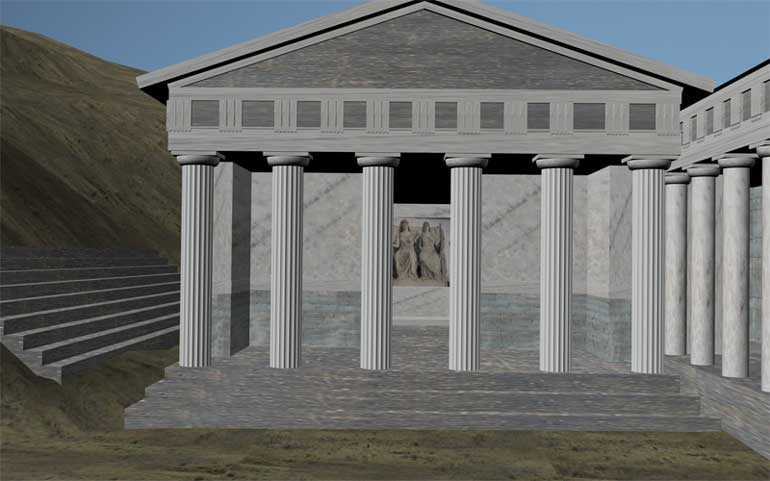
The acrolithic statues of Demeter (L) and Despoina (R) are visible at scale in the cella. At right is the Stoa, and at left is the theater-like seating area. (Source)
References
- Dinsmoor, William Bell, 1975. The Architecture of Ancient Greece: An Account of its Historic Development. New York: Norton Press.
- Jost, M. 1985. Sanctuaries et cults d'Arcadie. Paris.
- — 1994. "The Distribution of Sanctuaries in Civic Space in Arkadia." In S.E. Alcock and R. Osborne (eds.), Placing the Gods, Oxford, pp. 217-30.
- Kavvadias, P. 1893. Fouilles de Lycosoura. Athens.
- Lawrence, A. W. 1996. Greek Architecture 5th Edition. New Haven: Yale University Press.
- Leonardos, V. 1896. "Ανασκαφαι του εν Λυκοσουρα ιερου της Δεσποινης." Praktika.
- Meyer, E. 1926. Paulys Real-Encyclopädie der Classischen Altertums-Wissenschaft 13, 2417-32, “Lykosoura.”
- Stewart, Andrew. 1990. Greek Sculpture: An Exploration. New Haven: Yale University Press.
- Wace, A.J.B. The Veil of Despoina. The American Journal of Archaeology. 38:1, 1934.
- This article incorporates text from the Encyclopædia Britannica Eleventh Edition, a publication now in the public domain.
Notes
- ^ Pausanias 8.37.9-10
- ^ Pausanias 8.2.1
- ^ Pausanias 8.38.1
- ^ Pausanias 8.4.1-5
- ^ Pausanias 8.27.1-6
- ^ Pausanias 8.27.6
- ^ a b c Jost 1985
- ^ Pausanias 8.36.9
- ^ a b c Meyer
- ^ Pausanias 8.37.1
- ^ Lawrence
- ^ Pausanias 8.37.1-2
- ^ Pausanias 8.37.2
- ^ a b Wace
- ^ Pausanias 8.37.10-11
- ^ Pausanias 8.37.8
- ^ Pausanias 8.37.3-5
- ^ Pausanias 8.37.3
Links
Greece :
A - B - C - D - E - F - G - H - I - J - K - L - M -
N - O - P - Q - R - S - T - U - V - W - X - Y - Z
| Ancient Greece
Science, Technology , Medicine , Warfare, , Biographies , Life , Cities/Places/Maps , Arts , Literature , Philosophy ,Olympics, Mythology , History , Images Medieval Greece / Byzantine Empire Science, Technology, Arts, , Warfare , Literature, Biographies, Icons, History Modern Greece Cities, Islands, Regions, Fauna/Flora ,Biographies , History , Warfare, Science/Technology, Literature, Music , Arts , Film/Actors , Sport , Fashion --- |
Retrieved from "http://en.wikipedia.org/"
All text is available under the terms of the GNU Free Documentation License


